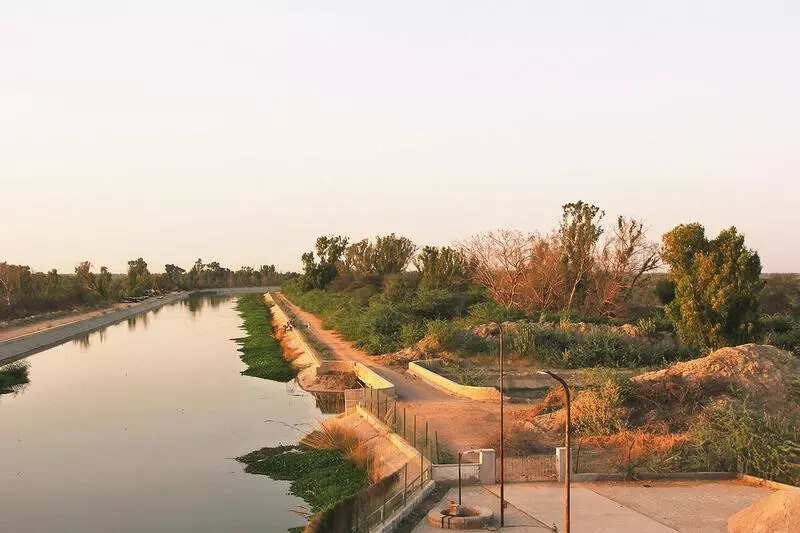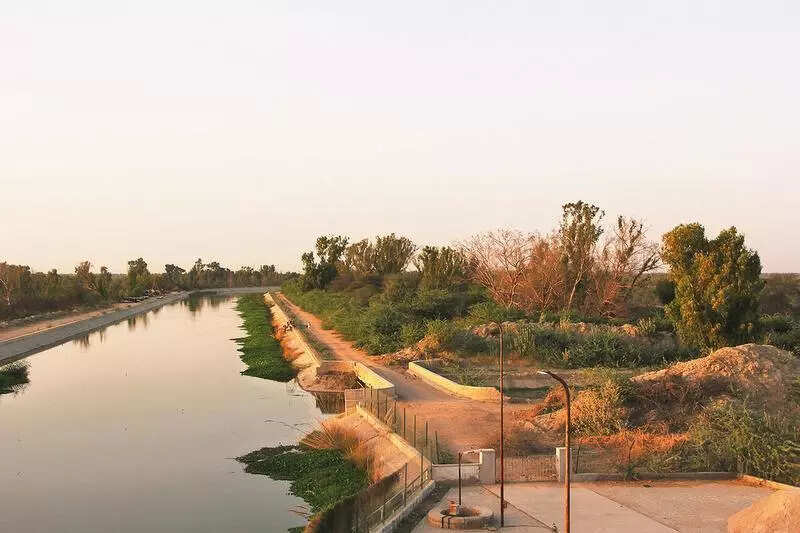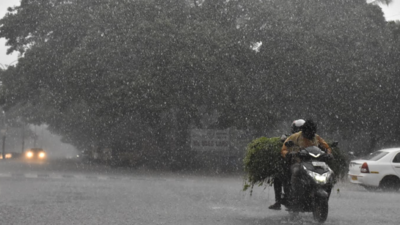In the heart of Rajasthan’s Thar Desert, an hour’s drive from Jaisalmer on a shimmering asphalt road, flanked by vast expanses of rocky terrain and sandy patches dotted with wild grass and babul trees, lies Ramgarh. Once an obscure desert village with a handful of dwellings in the 1980s, Ramgarh has transformed into a bustling agricultural market town. The air hums with the whir of speeding tractors hauling threshers and farm produce, while buses overflow with jubilant laborers heading home after a bountiful harvest. This vibrant scene stands in stark contrast to the desolate deserts of Bikaner, Jaisalmer, Barmer, and other districts, where survival was once a daily struggle.Like the labourers, Allah Ditta, a farmer near Ramgarh, rests on a charpoy under the sparse shade of a babul tree near a field, waiting for tractors to load his mustard harvest, neatly packed in sacks. “We had an excellent crop, but I could only cultivate 45 of my 60 hectares due to a shortage of canal water,” he says. Like Allah Ditta, tens of millions depend on the life-giving waters of the Indira Gandhi Nahar Pariyojana (IGNP), affectionately called the ‘Ganges of the Desert’. This 649-km canal, channeling water from the Himalayas, has reshaped the forsaken landscapes of the Thar, enabling agriculture across 16 lakh hectares, fostering greenery over 500 sq km, and meeting the drinking water needs of 20 million people. In just decades, it has transformed 20% of the Thar Desert, a feat unmatched in scale and ambition.Destiny Delayed, Not DeniedThe seeds of this transformation were sown over a century ago. Soon after the coronation of Ganga Singh as the Maharaja of Bikaner princely state in 1898, a devastating famine struck the region leading to deaths of thousand people and livestock. The devastation became a turning point in the young king’s life, and water security became his life’s mission. By 1927, he built the Gang Canal, played a catalytic role in the Bhakra project and drafted the first blueprint for the present-day Indira Gandhi Nahar. With his demise in 1943, the aspiration to create a larger version of the Gang canal went into deep freeze, though the idea did not die.Post-Independence, the project gained traction. The resolution of the Indus Waters Treaty with Pakistan in 1960 and agreements on sharing Ravi and Beas River waters among Punjab, Jammu and Kashmir, and Rajasthan cleared the way. In 1958, Home minister GB Pant inaugurated the canal’s construction at Harike Barrage in Punjab. By 1961, the ‘Ganges of the Desert’ began flowing, weaving a 649-km lifeline through the 3,50,000 square kilometers of desert terrain. Over the next four decades, it irrigated barren lands, spurred agriculture, fostered greenery, and supported livestock, lifting 20% of the Thar’s 19 million hectares out of desolation.Centuries Of Suffering, Reduced In DecadesAs April’s scorching sun pushes temperatures past 45°C, farmers and laborers in the Thar work tirelessly to harvest wheat, mustard, cumin, and psyllium husk (isabgol) — crops unimaginable before the canal’s arrival. Unlike Allah Ditta, farmers like Ram Singh Bishnoi have built farm ponds, ranging from 1-3 acres, to store water year-round, enabling cultivation of date palms, kinnow, and Thai apples alongside traditional crops. “Who could have thought these forsaken deserts would become a blessing for this deprived region? It’s undoubtedly the most ambitious project, not just in India, but in the world,” says Bishnoi, one of the first to receive 60 hectares of land from the Colonisation department under the IGNP board.In a region with less than 10 inches of annual rainfall, the canal has generated agricultural output worth of around Rs 6,500 crore annually against the Rs 7500 crore investment made toward the construction of INGP and its 9,000-km distributary system. Once barren areas like Mohangarh, Ramgarh, and Suthar Mandi now host thriving agricultural markets, testament to the canal’s transformative power.Ganges of the Desert and Its GreensideThe canal’s impact extends beyond agriculture. According to the India State Forest Report 2023, Jaisalmer’s forest cover has grown from 23 sq km in 1991 to 341 sq km, covering 0.9% of its 38,381 sq km area. In Bikaner, green coverage has risen from 0.2% (51 sq km) to 0.9% (260 sq km). This verdant spread has stabilised shifting sand dunes, reduced wind speeds, and facilitated road development, boosting trade and industry. The canal’s greenery has turned deserts into oases, fostering biodiversity and improving connectivity.Life Before and The BaneLife in the Thar was once brutally harsh. It continues to be in the areas that the IGNP does not touch. When wells (locally called tankas) dried up in summer, women trekked miles with mud pitchers for water. Livestock perished during frequent monsoon failures, forcing semi-nomadic migrations. Water was so scarce that locals cleaned utensils with sand, a practice some still follow. “People even used sand for personal hygiene after nature’s call,” says Deepak Saharan, who studies rural life in the region.Before the canal, agriculture was virtually nonexistent. The state govt invited farmers from neighboring districts like Sriganganagar, Hanumangarh, and Punjab, allotting them vast tracts of govt land for nominal fees. Nearly 2 lakh people have received over 12 lakh hectares along the canal, fuelling Rajasthan’s rise as the largest producer of isabgol and the second largest in cumin, while maintaining leadership in mustard, guar, and pearl millets. Of the 65 lakh livestock in Jaisalmer, Bikaner, and Churu, 40% rely on the canal for sustenance.Canal Construction and the ConundrumBuilding a 649-km canal through the Thar was a monumental challenge. Sandstorms obliterated trodden paths, disorienting survey teams. “Even 50 meters from camp, a sandstorm could mean permanent disappearance,” recalls Vinod Chaudhary, a retired IGNP chief engineer. Workers from Madhya Pradesh, Bihar, and Odisha were reluctant to endure the harsh conditions, requiring incentives like evening film screenings under a World Bank programme. Before modern machinery, donkeys and camel carts moved soil, with one 10-km stretch taking a year to complete. Transporting bricks, cement, and water across eerie terrains demanded meticulous logistics.Flow, Lift, and FlowWhile water flowed naturally on the canal’s western side due to sloping terrain, the arid eastern side required lift irrigation. The Loonkaransar project in Bikaner, completed in 1976 and later renamed after Kanwar Sain, marked the start. Narendra Singh Tanwar, who oversaw the Kolayat lift irrigation project, notes ongoing efforts to expand irrigation from 60,000 to 1 lakh hectares through community water ponds and sprinkler systems. The IGNP has invested Rs 714 crore in sprinkler irrigation across four projects to cover 2 lakh hectares.Water for All: Army and IndustryThe canal sustains the Border Security Force (BSF) along the 1,000-km India-Pakistan border and the Army’s heavy deployments. It also supports industries, power stations, the Pachpadra refinery, and other establishments, diverting 451 cusecs (110 crore liters per second) for their use.Repair and Road AheadThe canal’s closure for renovation in 2025 sparked local outcry, but Kunji Lal Meena, IGNP board chairman, emphasizes its necessity. “Repairing decades of wear and tear is critical for long-term use,” he says. Since 2020, the canal has been closed during the lean period between Rabi and Kharif crops for relining to prevent seepage. Reservoirs are filled before closures to ensure drinking water supply. The canal, closed on April 21, 2025, will resume flow on May 28.The IGNP is also building reservoirs with 20-40 km perimeters and 10-meter depths to serve 2 lakh households, reducing excess water flow to Pakistan’s Bahalpur. Vivek Goyal, chief engineer of IGNP said, “They will reduce by 50% of the extra water that flows downstream of Ravi and Beas to Bahalpur in Pakistan.”However, Rajasthan receives only 7.59 MAF of its allocated 8.59 MAF due to Punjab’s reluctance to share surplus water, a lingering point of contention from the 1981 inter-state treaty.The Indira Gandhi Nahar Pariyojana stands as a testament to human ingenuity, turning deserts into fertile lands and breathing life into a region once deemed uninhabitable. Its legacy continues to grow, promising a greener, more prosperous future for the Thar.
Colossal canal that greened the Thar | Jaipur News





